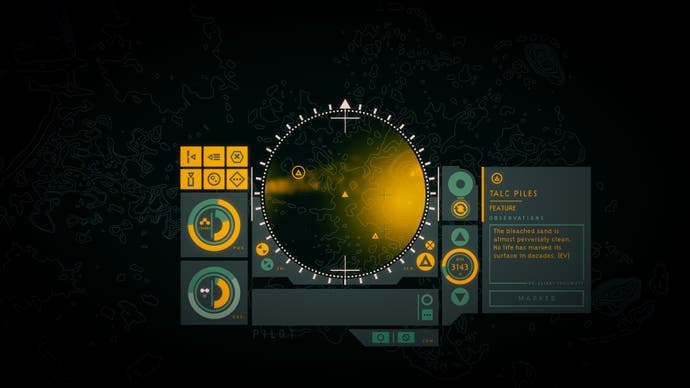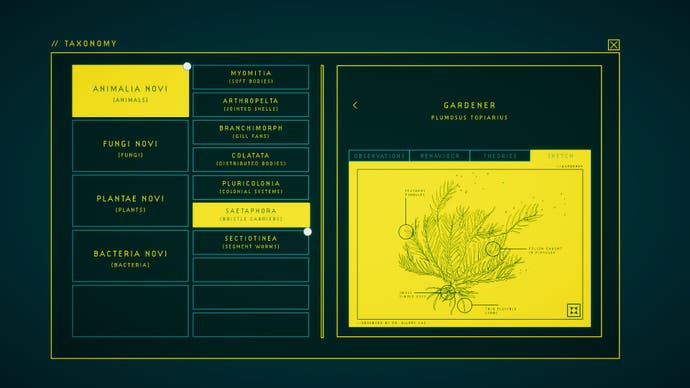In Other Waters review - an ocean sanctuary for the meditative explorer
Current events.
It begins with one of the loveliest interfaces I've ever handled, a fluorescent origami puzzle of panels, dials and buttons, at once tactile and ethereal, vintage and high-tech, like a holographic astrolabe. At its centre, a circle of ocean rendered in the style of an old-time sea chart, its delicately nested contours travelling beyond the dashboard into a turquoise haze.
A tap of space bar sends out a wailing sonar wave, populating that circle of water with triangular waypoints and coloured dots, darting through or forming undulating patterns - creatures, going about their lives without much heed for the fumbling, dive-suited human in their midst. Tap a waypoint to scan it, a brief but evocative description filling a fold-out panel to the right. Push one of the larger buttons to set that waypoint as a destination, a sextant arm locking across the view with a gratifying click. Hit another button to engage the suit's thrusters, then hit space on arrival to scan your surroundings anew.

This is the heartbeat of In Other Waters, a unique and mesmerising exploration game from Jump Over The Age, set on an alien planet. It's a tempo that carries you from sunlit shallows to waters clogged with poisonous microbes, from pillars decked with pollen to abyssal reaches that harbour dreadful secrets. There is little to break the rhythm - no in-game antagonist to defeat, and only a small handful of tools such as laser cutters that open up initially inaccessible regions. Even the occasional terrain hazards, which range from stinging veils to pools of corrosive brine, are more like encouragements to keep moving than threats.
That ritual of scanning and setting a course may sound monotonous. During the first of my eight hours with the game, I worried that the cetacean whistles and clicks of the wonderfully tuned interface might begin to grate, that repetition might tempt me to skim past vital pieces of text. That temptation is fiercest when you're wandering through toxic water, your eye flicking between a dwindling O2 reserve on the left and the leisurely unfolding commentary on the right. But these oppressive regions are manageable enough once your panic is cooled - your suit can metabolise scraps of organic matter for oxygen and power, and the only penalty for running out is being recovered by drone and obliged to start that region over.
After a while, you realise what the game is asking of you: not just curiosity but reflection and a certain method, a willingness to sample this ocean one bit at a time, as a considerate scientist would. You also realise that what you're doing when you move and scan is weaving two lifeforms together - a xenobiologist, Dr Ellery Vas, who is searching these undiscovered waters for somebody she once knew, and the strange AI unit she finds abandoned on a reef.

Ellery can't operate the suit herself: rather, she sets broad objectives, region by region, leaving it up to you how you achieve them and what you investigate along the way. Her agency in the field consists of remarking on and writing up the creatures and things you find. You can't communicate with her beyond responding "yes" or "no" to very infrequent questions, but the act of exploration constitutes a dialogue, a tidal back-and-forth between an AI's visualisations and a human's powers of description and analysis.
That player-enacted symbiosis facilitates a well-paced, exposition-lite story about coexisting with nonhuman life, against the ravages of interplanetary capitalism. Ellery is an employee of Baikal, a corporation that strips whole worlds of resources. Working for this entity is the price she pays for escaping an Earth whose seas have been sterilised by climate change. She's a survivor, then, but she is still a scientist, and Gliese 667Cc - an actual, potentially habitable exoplanet, previously visited by the Alien vs Predator franchise - is everything Earth has lost. You'll encounter scores of bewitching lifeforms, each a cluster of dots that moves and reacts in a way suggestive of great behavioural complexity. Rather than killing these creatures to add them to a bestiary, as in many exploration sims, you'll learn from their leavings - scooping up bits of plant frond or shell with a tool that resembles a shutter-operated camera, and storing them at the laboratory you uncover early in the game.
The lab itself - which serves as a chapter-breaking hub - is a delightful specimen, its floors stacked like slides under a microscope. Here, you can analyse samples you've collected to fill out a database, Ellery's initial observations and speculations blooming into marvellously nerdy accounts of predation and reproduction. The game's lead designer and writer Gareth Damian Martin is a florid stylist, but he and his co-writers strike a balance in the game between rhapsody and clinical precision. Gather enough data and you'll unlock a sketch of the creature, a postcard to the AI from Ellery's world.

The creatures are like nothing else you'll find in a game, their eerieness only amplified by the knowledge that they are mournful homages to organisms whose habitats we are destroying. I'll try not to spoil them too much, but we're a long way from videogame staples like sharks. There's a huge emphasis on interdependence: every organism is the way it is thanks to its interactions with another, be it turning a much larger organism into a habitat, or cultivating bacteria for food. Some organisms are in fact several, entwined together like Ellery and the AI.
Fascinating revelations, indeed, but as a mechanic the taxonomy system feels a bit wayward. Progress through the game is broadly defined by a database completion percentage, visible on your save file. Maxing a percentage is the hallmark of a more ruthless, acquisitive fantasy than In Other Waters - it clashes with the pliant tone of Ellery's notes, which often end with yet more questions. Accepting the planet's mysteries rather than trying to unravel every last one is part of the game's ecological message, and as such, that touch of completionism seems out of place.
It's a tiny quibble, though, forgotten the second you venture back out into the water. The game's colour palette is astonishing, creating an atmosphere most open world blockbusters can only dream of. Beyond that opening wash of radioactive turquoise and sherbet yellow, you can expect glaring stews of red and green, and sunken recesses where the map is a tracery of bone emerging from midnight blue. Amplifying the mood is Amos Roddy's meditative electronic score, which is elegantly attuned to the unfolding plot. Some of the major dramatic beats are tethered to melodies, played out note by note as you click between lines.
It might seem annoying that you can't "escape" In Other Waters' interface and explore the naturalistic three-dimensional landscape hinted at by Ellery's sketches - certainly, I'd love to see a 3D interpretation of one particular colonial lifeform - but that's missing the point. The AI's perspective is reality, its collaboration with Ellery producing a world. That concept of reality as a co-production, fashioned by on-going interaction and acceptance, is anathema to the version offered by Baikal, which cynically divides existence into humans and the things we use. It's a concept In Other Waters makes you live, scan by scan, waypoint by waypoint, as you contemplate an ocean that is every bit as unreal and fragile as our own.
Disclaimer: In Other Waters creator Gareth Damian Martin is a former Eurogamer contributor.













